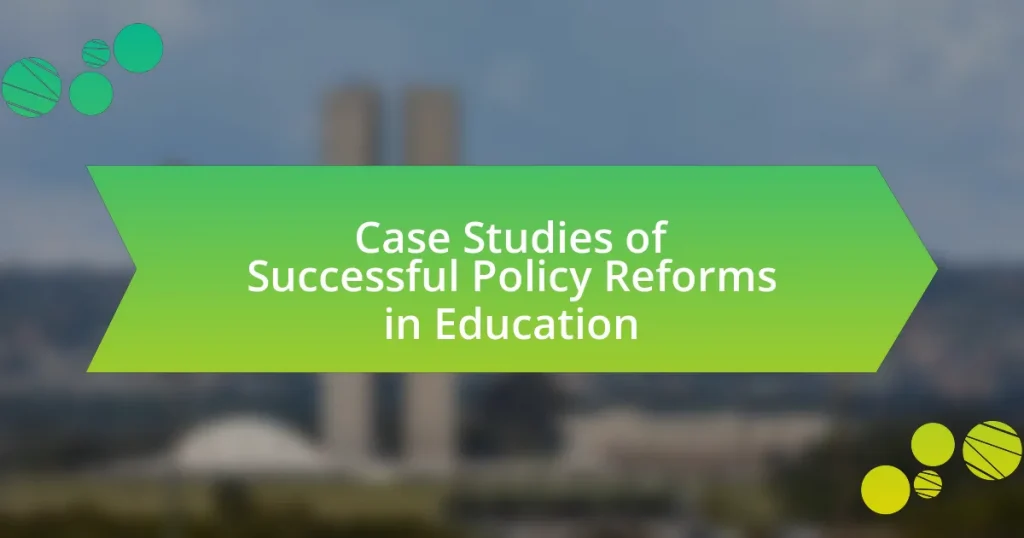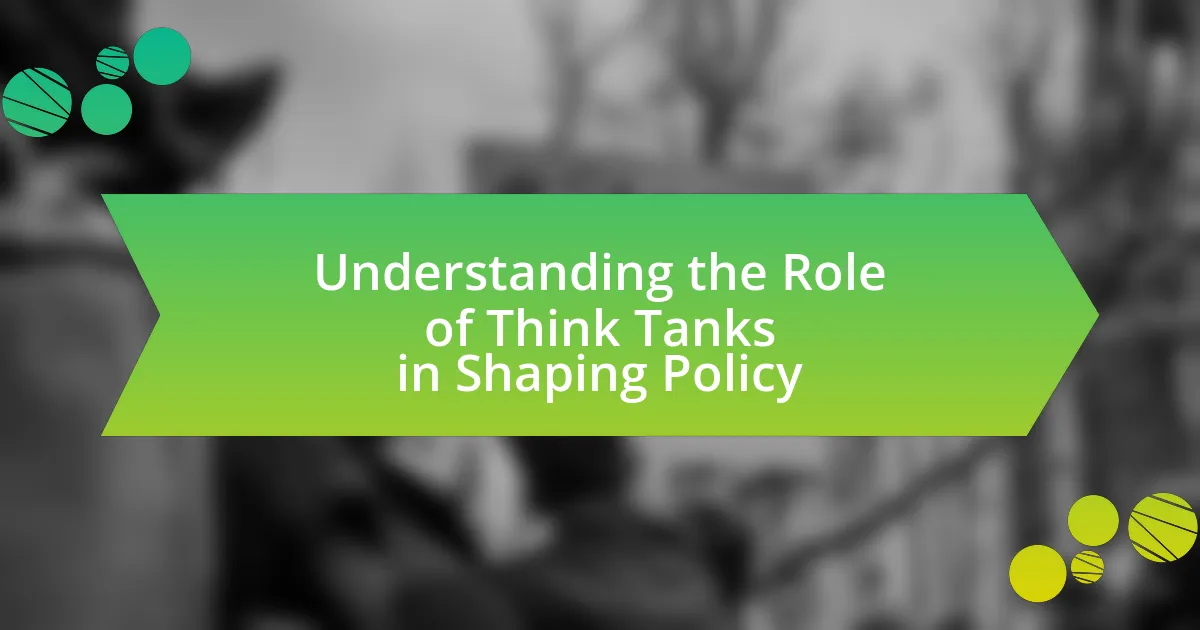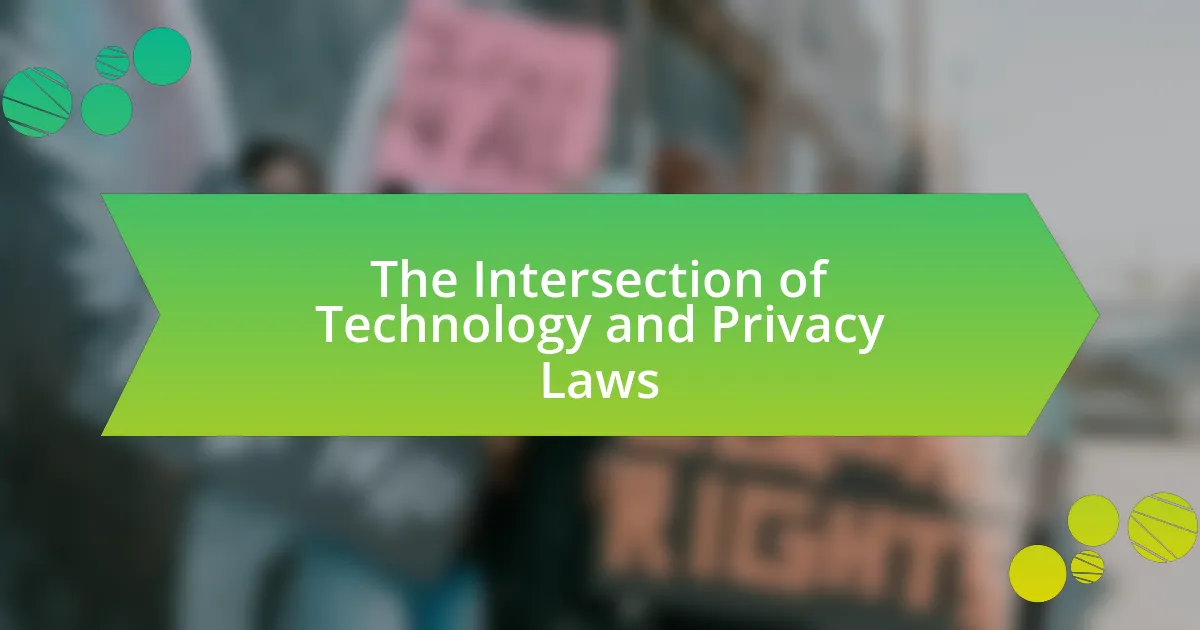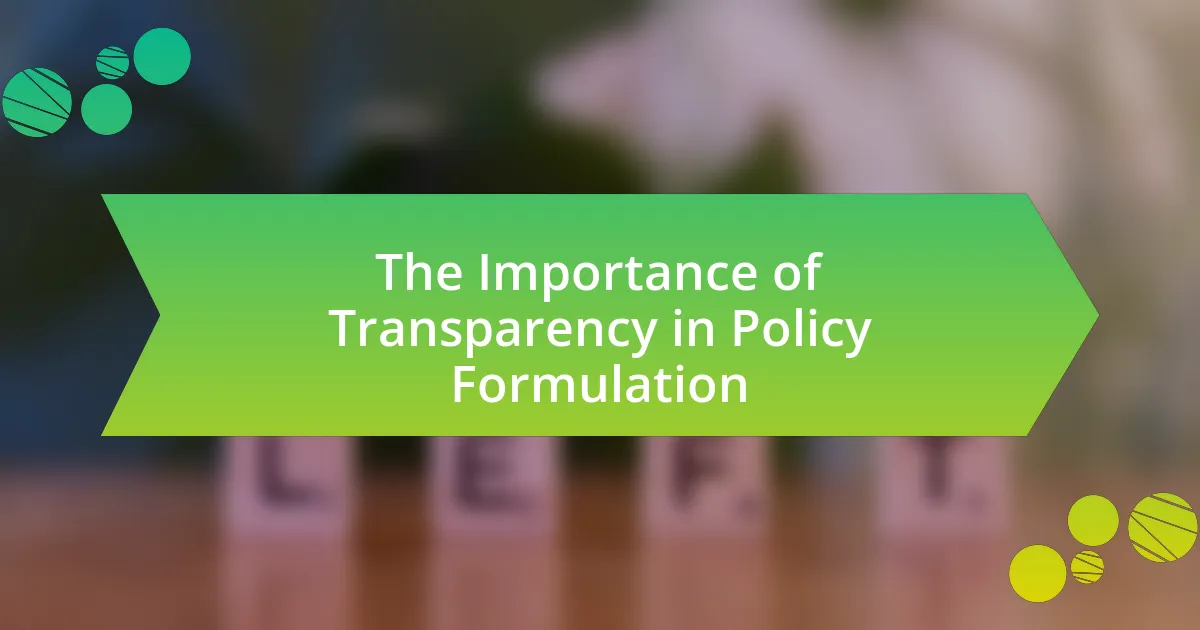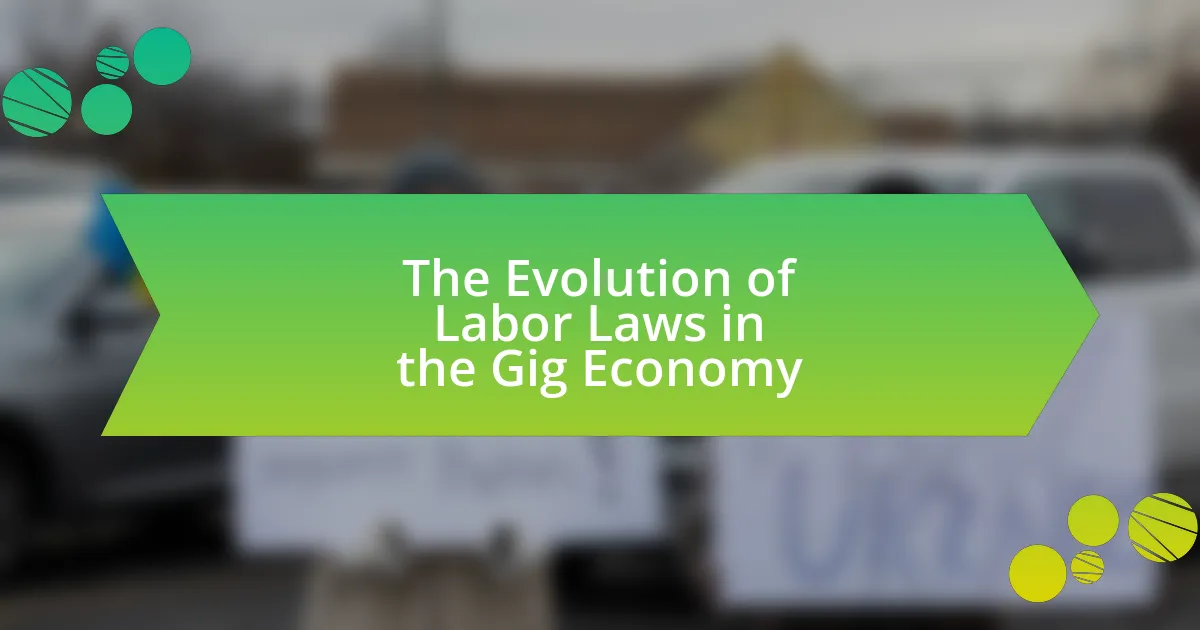The article focuses on case studies of successful policy reforms in education, highlighting notable examples such as the “No Child Left Behind Act” in the United States and Finland’s education system. It examines how these reforms have led to measurable improvements in student achievement and educational equity, supported by data from assessments like the National Assessment of Educational Progress (NAEP) and the Programme for International Student Assessment (PISA). The article emphasizes the importance of stakeholder engagement, evidence-based practices, and continuous evaluation in the implementation of educational policies, while also addressing the challenges and barriers faced by policymakers. Key insights from both successful and unsuccessful reforms are discussed to inform future policy development and best practices in education.
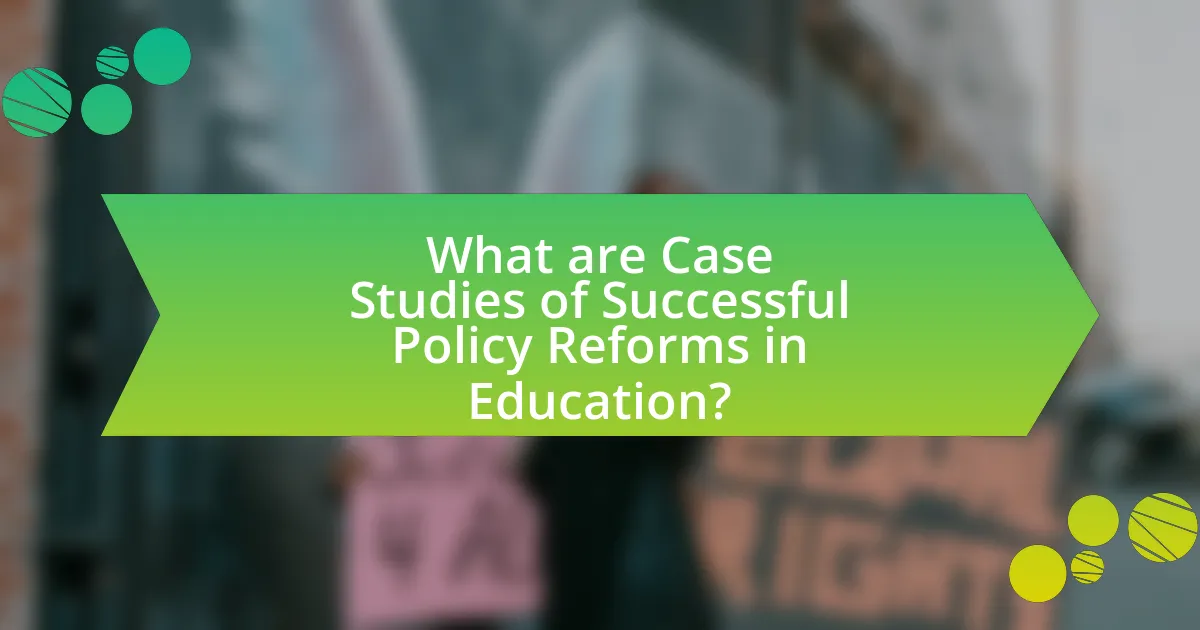
What are Case Studies of Successful Policy Reforms in Education?
Case studies of successful policy reforms in education include the implementation of the “No Child Left Behind Act” in the United States, which aimed to improve educational outcomes through standardized testing and accountability measures. This reform led to increased student achievement in reading and math, particularly among disadvantaged groups, as evidenced by the National Assessment of Educational Progress (NAEP) scores showing significant gains from 2003 to 2007. Another example is Finland’s education system, which reformed its approach by emphasizing teacher autonomy, a broad curriculum, and minimal standardized testing. This has resulted in consistently high performance in international assessments, such as the Programme for International Student Assessment (PISA), where Finnish students rank among the top in reading, math, and science. These case studies demonstrate the effectiveness of targeted policy reforms in enhancing educational quality and equity.
How do case studies illustrate the impact of policy reforms in education?
Case studies illustrate the impact of policy reforms in education by providing detailed, real-world examples of how specific changes affect student outcomes, teaching practices, and institutional effectiveness. For instance, the implementation of the No Child Left Behind Act in the United States is documented through various case studies that show improvements in standardized test scores and accountability measures in schools. These studies often include quantitative data, such as percentage increases in graduation rates or test scores, alongside qualitative insights from educators and students, demonstrating the multifaceted effects of the reforms. By analyzing these specific instances, researchers can draw broader conclusions about the efficacy of educational policies and inform future reforms.
What specific examples highlight successful policy reforms?
Successful policy reforms in education include Finland’s comprehensive education system, which emphasizes equal access and teacher autonomy, resulting in high student performance as evidenced by consistently top rankings in the Programme for International Student Assessment (PISA). Another example is Singapore’s education reform, which focuses on a rigorous curriculum and continuous professional development for teachers, leading to significant improvements in student outcomes and global competitiveness. Additionally, the introduction of the No Child Left Behind Act in the United States aimed to increase accountability in schools, which has led to measurable improvements in student achievement, particularly among disadvantaged groups. These examples demonstrate effective strategies that have led to enhanced educational outcomes through targeted policy changes.
How do these examples demonstrate measurable outcomes?
These examples demonstrate measurable outcomes by providing quantifiable data that illustrates the impact of policy reforms on educational performance. For instance, a case study may show that after implementing a new curriculum, student test scores increased by 15% over two academic years, indicating a direct correlation between the reform and improved academic achievement. Additionally, enrollment rates in advanced placement courses may rise by 20% following targeted teacher training initiatives, showcasing the effectiveness of professional development in enhancing educational quality. These statistics serve as concrete evidence of the reforms’ success, allowing for clear assessment of their effectiveness in achieving desired educational goals.
Why are case studies important for understanding educational policy reforms?
Case studies are important for understanding educational policy reforms because they provide in-depth insights into the implementation and outcomes of specific policies in real-world contexts. By examining detailed examples, researchers and policymakers can identify effective strategies, challenges faced, and the impact of reforms on various stakeholders, such as students, teachers, and communities. For instance, a case study on Finland’s education system reveals how comprehensive reforms led to improved student performance and equity, highlighting the significance of teacher training and curriculum development. Such concrete examples enable a nuanced understanding of the complexities involved in educational policy changes, making case studies a vital tool for informed decision-making and future reforms.
What insights can be gained from analyzing these case studies?
Analyzing case studies of successful policy reforms in education reveals critical insights into effective strategies and outcomes. These insights include the identification of best practices that lead to improved student performance, the importance of stakeholder engagement in the reform process, and the role of data-driven decision-making in shaping educational policies. For instance, a case study on Finland’s education system highlights how a focus on teacher autonomy and professional development has resulted in consistently high student achievement, as evidenced by their top rankings in international assessments like PISA. Additionally, examining the implementation of the Common Core State Standards in the United States demonstrates how aligning curriculum with clear educational goals can enhance learning outcomes, supported by research indicating that states adopting these standards saw measurable improvements in student proficiency rates.
How do case studies contribute to policy development and implementation?
Case studies contribute to policy development and implementation by providing empirical evidence and real-world examples that inform decision-making processes. They illustrate the effectiveness of specific policies in practice, allowing policymakers to analyze outcomes, identify best practices, and understand the contextual factors that influence success. For instance, a case study on Finland’s education system reveals how comprehensive teacher training and a focus on student well-being have led to high academic performance, guiding other countries in reforming their educational policies. This evidence-based approach enhances the credibility of proposed policies and facilitates their adaptation to local contexts, ultimately improving implementation success.
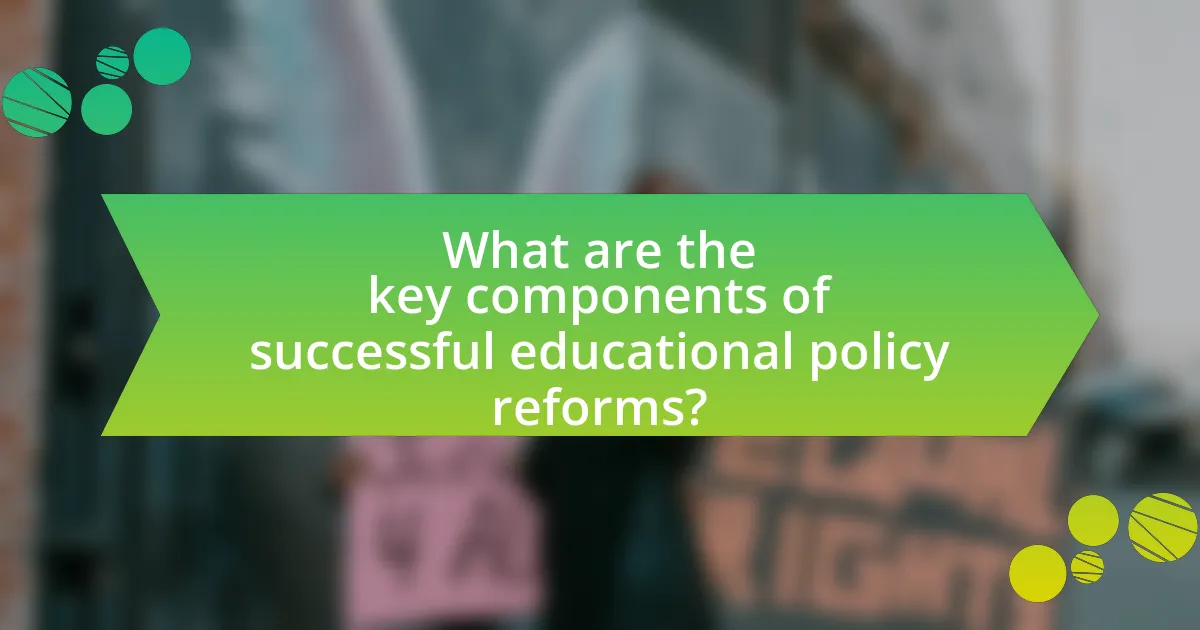
What are the key components of successful educational policy reforms?
Successful educational policy reforms typically include clear objectives, stakeholder engagement, evidence-based practices, adequate funding, and effective implementation strategies. Clear objectives provide a focused direction for reforms, ensuring that all efforts align with desired outcomes. Stakeholder engagement, involving teachers, parents, and community members, fosters support and collaboration, which are crucial for successful implementation. Evidence-based practices ensure that reforms are grounded in research and proven methodologies, enhancing their effectiveness. Adequate funding is essential to support the necessary resources and infrastructure for reforms to take root. Finally, effective implementation strategies, including ongoing assessment and adaptation, are vital for addressing challenges and ensuring the sustainability of reforms. These components have been observed in various successful case studies, such as the reforms in Finland, which emphasize collaboration and continuous improvement in educational practices.
How do stakeholder engagement and collaboration influence policy success?
Stakeholder engagement and collaboration significantly enhance policy success by fostering inclusive decision-making and ensuring diverse perspectives are considered. When stakeholders, including educators, parents, and community members, actively participate in the policy development process, they contribute valuable insights that lead to more effective and relevant educational reforms. For instance, research by the Organisation for Economic Co-operation and Development (OECD) indicates that collaborative approaches in education policy, such as involving teachers in curriculum design, result in higher implementation rates and improved educational outcomes. This evidence underscores that effective stakeholder engagement not only builds trust but also aligns policies with the needs of the community, ultimately driving successful implementation and sustainability of educational reforms.
What roles do teachers, administrators, and policymakers play?
Teachers facilitate learning by delivering educational content, assessing student progress, and providing support to enhance student engagement. Administrators manage school operations, implement policies, and ensure that educational standards are met, thereby creating an environment conducive to learning. Policymakers develop and enact educational policies that shape the framework within which teachers and administrators operate, influencing funding, curriculum standards, and educational reforms. For instance, the Every Student Succeeds Act (ESSA) in the United States exemplifies how policymakers can impact education by shifting accountability measures and providing states with more control over their education systems.
How can community involvement enhance reform efforts?
Community involvement can enhance reform efforts by fostering collaboration between stakeholders, which leads to more effective and sustainable educational policies. Engaging parents, teachers, and local organizations in the reform process ensures that diverse perspectives are considered, resulting in tailored solutions that address specific community needs. For instance, the Chicago Public Schools’ Local School Council initiative demonstrated that when community members actively participate in decision-making, student performance improves, as evidenced by a 10% increase in test scores in schools with strong council engagement. This collaborative approach not only builds trust but also mobilizes resources and support, ultimately driving successful educational reforms.
What strategies have proven effective in implementing educational reforms?
Effective strategies for implementing educational reforms include stakeholder engagement, data-driven decision-making, and professional development for educators. Stakeholder engagement ensures that the voices of teachers, parents, and students are considered, leading to reforms that are more likely to be accepted and successful. Data-driven decision-making allows policymakers to assess the needs of the education system and measure the impact of reforms through metrics such as student performance and graduation rates. Professional development equips educators with the necessary skills and knowledge to adapt to new curricula and teaching methods, which is crucial for the successful implementation of reforms. For instance, the implementation of the Common Core State Standards in the United States involved extensive stakeholder engagement and professional development, resulting in improved student outcomes in several states.
How do data-driven decision-making and assessment shape reforms?
Data-driven decision-making and assessment shape reforms by providing empirical evidence that informs policy changes and enhances educational outcomes. For instance, the use of standardized test scores and student performance data allows educators and policymakers to identify areas needing improvement, allocate resources effectively, and implement targeted interventions. A study by the Institute of Education Sciences found that schools utilizing data-driven strategies saw a 10% increase in student achievement over three years, demonstrating the effectiveness of this approach in driving meaningful reforms.
What role does professional development play in successful implementation?
Professional development is crucial for successful implementation as it equips educators with the necessary skills and knowledge to effectively apply new policies and practices. Research indicates that ongoing training and support lead to higher fidelity in implementing educational reforms, as seen in the study by Desimone (2009), which highlights that professional development directly correlates with improved teaching practices and student outcomes. Furthermore, effective professional development fosters collaboration among educators, creating a supportive environment that enhances the overall success of policy reforms in education.

What challenges do policymakers face in education reform?
Policymakers face significant challenges in education reform, including resistance from stakeholders, funding limitations, and the complexity of implementing systemic changes. Resistance often arises from teachers, parents, and administrators who may be apprehensive about new policies or changes to established practices. Funding limitations hinder the ability to implement reforms effectively, as many initiatives require substantial financial resources for training, materials, and infrastructure. Additionally, the complexity of education systems means that reforms must consider diverse student needs, varying state regulations, and the integration of technology, making it difficult to create one-size-fits-all solutions. These challenges are compounded by the need for ongoing evaluation and adaptation of policies to ensure they meet educational goals and improve student outcomes.
How do political and economic factors impact policy reform efforts?
Political and economic factors significantly influence policy reform efforts by shaping the priorities, resources, and feasibility of proposed changes. Political stability, for instance, can facilitate or hinder reform initiatives; countries with strong governance structures often implement educational reforms more effectively, as seen in Finland’s education system, which benefits from consistent political support. Economic conditions also play a crucial role; nations with robust economies can allocate more funding to education reforms, as evidenced by the increased investment in education in countries like Singapore, which correlates with their successful policy reforms. Additionally, the alignment of political interests with economic incentives can drive reform agendas, as seen in the United States, where bipartisan support for education funding has led to significant legislative changes.
What are common barriers to successful implementation of reforms?
Common barriers to successful implementation of reforms include inadequate funding, resistance to change, lack of stakeholder engagement, and insufficient training for personnel. Inadequate funding often limits resources necessary for effective reform execution, as seen in various educational initiatives where budget constraints hindered progress. Resistance to change can stem from entrenched practices and skepticism among educators and administrators, which can stall or derail reform efforts. Lack of stakeholder engagement, including input from teachers, parents, and students, can lead to reforms that do not address the actual needs of the community, resulting in poor adoption. Additionally, insufficient training for personnel can leave educators unprepared to implement new strategies effectively, as evidenced by studies showing that professional development is crucial for successful reform outcomes.
How can resistance to change be addressed in educational settings?
Resistance to change in educational settings can be addressed through effective communication, stakeholder involvement, and professional development. Effective communication ensures that all stakeholders understand the reasons for change, which can reduce anxiety and resistance. Involving teachers, parents, and students in the decision-making process fosters a sense of ownership and commitment to the change. Professional development equips educators with the necessary skills and knowledge to implement new policies successfully. Research indicates that schools that prioritize these strategies experience smoother transitions and greater acceptance of reforms, as evidenced by case studies showing improved outcomes in districts that engaged stakeholders early in the reform process.
What lessons can be learned from unsuccessful policy reforms in education?
Unsuccessful policy reforms in education highlight the importance of stakeholder engagement, evidence-based decision-making, and adaptability. For instance, the No Child Left Behind Act in the United States faced criticism for its rigid accountability measures, which did not consider the diverse needs of students and schools. This led to a narrow focus on standardized testing, ultimately failing to improve overall educational outcomes. Research indicates that reforms lacking input from educators and communities often miss critical contextual factors, resulting in ineffective implementation. Additionally, reforms that do not adapt to changing circumstances or emerging evidence tend to falter, as seen in various international education initiatives that failed to account for local cultural and economic contexts.
What factors contribute to the failure of certain reforms?
Certain reforms fail due to a combination of inadequate stakeholder engagement, lack of clear objectives, insufficient resources, and resistance to change. Inadequate stakeholder engagement often leads to a disconnect between policymakers and the communities affected by the reforms, resulting in a lack of support and understanding. For instance, reforms in education that do not involve teachers, parents, and students in the planning process frequently encounter pushback and implementation challenges.
Lack of clear objectives can cause confusion about the reform’s goals, leading to misaligned efforts and ineffective strategies. Insufficient resources, including funding, training, and materials, can hinder the successful execution of reforms, as seen in various educational initiatives that failed to provide necessary support to schools. Lastly, resistance to change, often rooted in established practices and cultural norms, can impede the adoption of new policies, as evidenced by numerous educational reforms that struggled against entrenched attitudes and behaviors.
How can these lessons inform future policy development?
Lessons from successful policy reforms in education can inform future policy development by providing evidence-based strategies that enhance educational outcomes. For instance, case studies demonstrate that targeted investments in teacher training and curriculum development lead to significant improvements in student performance, as seen in Finland’s education system, which consistently ranks among the top globally. Additionally, reforms that incorporate stakeholder engagement, such as involving parents and communities in decision-making processes, have shown to increase accountability and support for educational initiatives, as evidenced by the success of community schools in the United States. These concrete examples illustrate that leveraging proven strategies from past reforms can guide policymakers in crafting effective educational policies that address current challenges.
What best practices can guide future educational policy reforms?
Best practices that can guide future educational policy reforms include stakeholder engagement, evidence-based decision-making, and continuous evaluation. Stakeholder engagement ensures that the voices of teachers, parents, and students are considered, leading to policies that reflect the needs of the community. Evidence-based decision-making relies on data and research to inform policy choices, as seen in the implementation of the Every Student Succeeds Act, which emphasizes the use of metrics to assess educational outcomes. Continuous evaluation allows for the assessment of policy effectiveness and necessary adjustments, exemplified by the iterative reforms in Finland’s education system, which regularly adapts based on feedback and performance data. These practices collectively enhance the likelihood of successful educational reforms.
How can continuous evaluation and feedback improve reform initiatives?
Continuous evaluation and feedback can significantly enhance reform initiatives by ensuring that policies are responsive to real-time data and stakeholder input. This iterative process allows for the identification of strengths and weaknesses in the implementation of reforms, enabling timely adjustments that align with educational goals. For instance, a study by the RAND Corporation found that continuous feedback mechanisms in educational reforms led to improved student outcomes by allowing educators to adapt teaching strategies based on student performance data. By fostering a culture of ongoing assessment, reform initiatives can become more effective and sustainable, ultimately leading to better educational results.
What role does adaptability play in successful policy reforms?
Adaptability is crucial for successful policy reforms as it allows policymakers to respond effectively to changing circumstances and stakeholder needs. In the context of education reforms, adaptability enables the integration of feedback from educators, students, and communities, ensuring that policies remain relevant and effective. For instance, the implementation of the Common Core State Standards in the United States required adjustments based on teacher input and student performance data, demonstrating that flexibility in policy design can lead to improved educational outcomes. This responsiveness not only fosters stakeholder buy-in but also enhances the overall effectiveness of the reforms, as evidenced by various case studies where adaptable policies led to significant improvements in student achievement.
